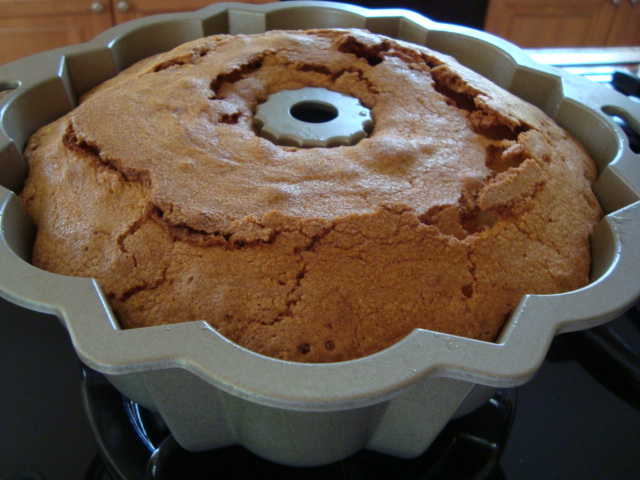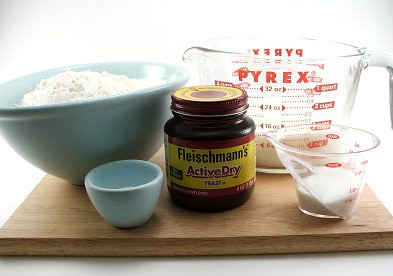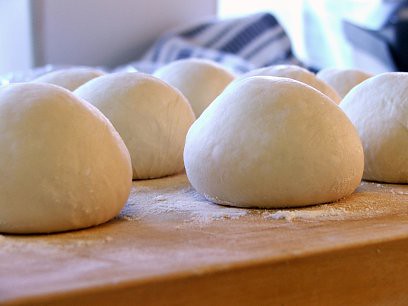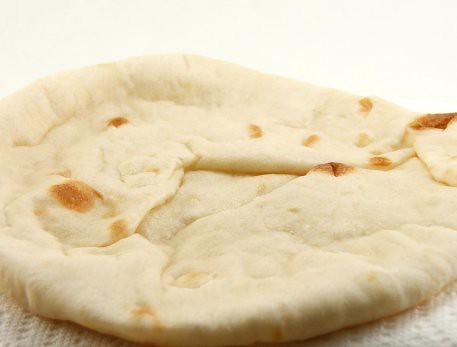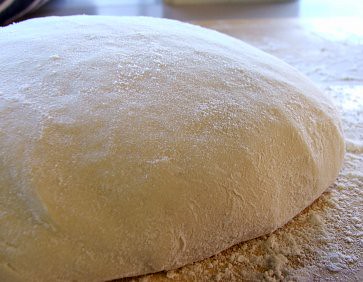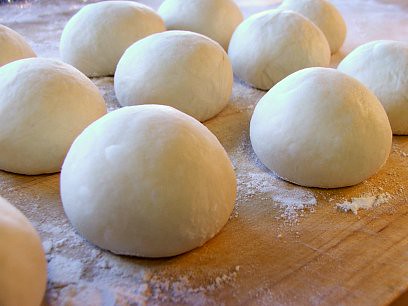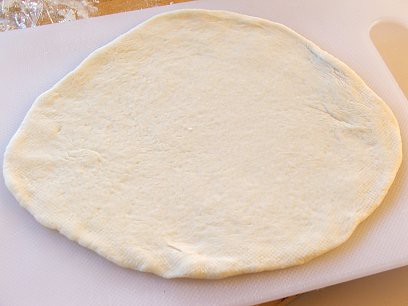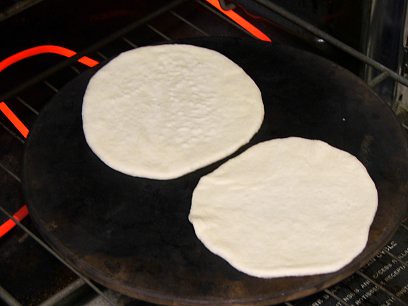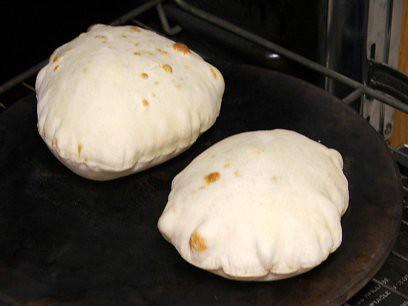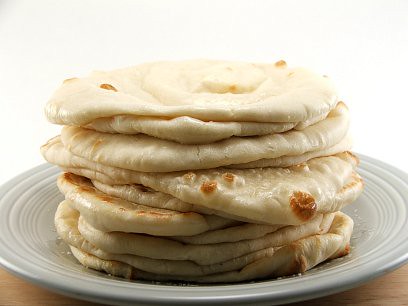Trying a new ingredient or a new formula excites me. If I find a new method or a new ingredient to make my daily bread the next morning, I go to sleep with a smile the night before. I read about the Chia seed in one of Johnny's comments on Sourdough Companion a long while ago and had tried Chia seeds with other grains and seeds several times but never on its own. I was happy with the results each time but never stopped to think why the results were good; I just moved on. I looked upon the Chia seed the same as any other grains and seeds.
It just so happened that last week I ran out of all the grains and seeds, except the Chia seeds. It was 10 days before my family were due to travel again and I was trying to run the fridge down and not to bake any more bread before we leave - the freezer was already chuck full of sourdoughs to bring away with us. But, I got excited over questions like: what would it be like to have Chia seeds, and Chia seeds alone, in my sourdough? and what would Chia seeds do to my daily bread?
I chose a simple sourdough recipe and added 7% Chia, pre-soaked in four times its weight in boiling water - only 7% because this is not like walnut bread where you want to actually bite into walnuts. I did not know at first how much water Chia seeds would absorb; nor did I want to trouble myself by soaking the seeds the night before. I knew boiling water could do the job on the spot. I first poured double its weight of boiling water over the seeds; the water was gobbled up in seconds, so I poured a bit more, and a bit more again a few minutes later, totaling four times the weight of the seeds. So, this is my first ever Chia sourdough:
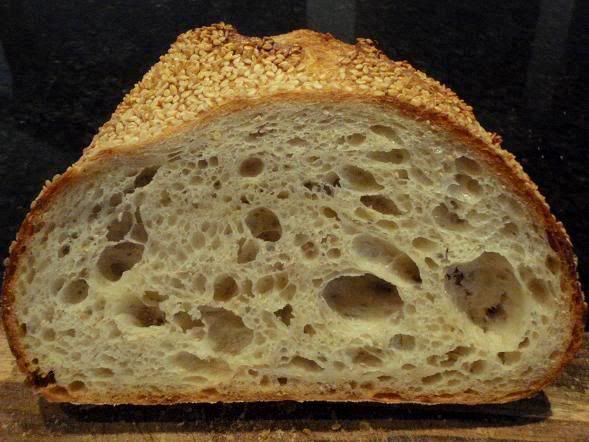
White Chia Sourdough
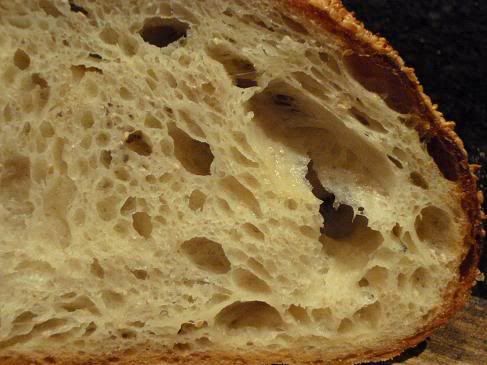
You cannot believe how moist the crumb was. It was so incredible.
I am so amazed at how good the bread was that I started to read up on the Chia seed. There is an article here that talks about Chia as the ancient grain of the future but it looks at it from the angle of nutrition which is not my concern here. I would recommend the article to anyone who is interested in the topics of omega-3, diet, antioxidants, vegan, or even gluten free solutions; but I am interested in what effects there are on bread, not nutrients. Here is what I have found with my experiments together with the relevant points from the article:
(1) Moisture: Chia has a very unusual property - a gelatinous, glue-like substance due to the soluble fiber that is able to absorb up to 12 times its weight in water. The seed's hydrophilic saturated cells hold the water when it is mixed in with flour. I picked up some pre-soaked Chia seeds and they did not wet my fingers one bit at all. With the bread in this post, I have found that the hydrophilic colloids in Chia prolonged moisture in the bread in the most spectacular way. The moisture which was initially contained in the cells of Chia slowly released itself, like a low GI food slowly releasing its sugar. (The article says that the Chia gel can form a barrier between carbohydrates and enzymes that break them down, thus slowing down the conversion of carbohydrates into sugar.)
This moisture is completely different from that in a super-high hydration loaf like Ciabatta which, in my experience, if not finished within a couple of days, turns as dry and tough, and as quickly, as anything I can think of. But it is similar to Hamelman's Five-Grain Levain, because of flaxseed, one of the five grains used in that bread. I have found that flaxseed, once soaked, has a similar gel-like property like Chia.
(2) Texture: The gelatinous, glue-like substance seems to have also altered the texture of the bread, resulting in softer crumb. In this regard, I think it is important not to over-hydrate the dough, otherwise you may lose the springiness and chewiness, typical of sourdough bread. I have also tried soaking the Chia seeds with six times their weight in water, while maintaining my other bakers percentages, and the result was very gummy crumb, most unpleasant to have.
The article mentioned above says that 8 parts water to one part Chia can be added to bread dough, but I think this would work only if you add a couple of tablespoons, not more, as was suggested and beautifully done by Sharon, the glutenfreesourdoughbaker, here.
(3) Taste: This may sound strange, but I have noticed my wholemeal sourdough now tastes sweeter than before. For people who don't like 100% whole wheat, Chia gel is like a "tonic" that would modify the bitterness in 100% whole wheat bread. We know most kids choose white bread over whole wheat bread because of the high fiber and bitter taste in whole wheat flour. Well, I've got news. I gave my kids and their friend a 100% wholemeal sourdough (with 7% Chia), they thought it tasted like a white sourdough and between the three of them they finished a 750g loaf!


Whole Wheat Chia Sourdough
Formula for my white Chia Sourdough
- 125 g Wholemeal Starter @100% hydration
- 500 g Flour (I used Australia's Laucke's unbleached bakers flour, protein 11.9%)
- 343 g Lukewarm Water *
- 11 g Salt
- 40 g white Chia Seeds
- 160 g Boiling Water
- Sesame Seeds for dusting
* I used lukewarm water to bring the final dough temperature to 26 C/ 78 F as my room temperature was cold, around 19 C/ 66 F
** Dough hydration was 72% (not taking into account the Chia and the boiling water to soak it). You may want to adjust hydration to suit your flour. Total dough weight was 1.1 kg.
Formula for my wholemeal Chia Sourdough
- 200 g Wholemeal Starter @100% hydration
- 600 g Wholemeal Flour (I used Australia's Four Leaf's 85% Light Flour, protein 14%)
- 460 g Lukewarm Water*
- 14g Salt
- 50 g white Chia Seeds
- 200 g Boiling Water for soaking the Chia seeds
- Sesame Seeds for dusting
*** Dough hydration was 80% (not taking into account the Chia and the boiling water to soak it). My wholemeal flour is a high gluten flour which is very thirsty for water. Adjust hydration if your WW flour is not as thirsty as mine. Total dough weight was 1.57kg.
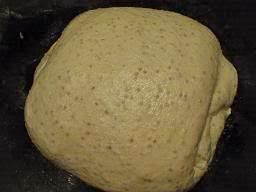

Method
Following were my steps that produced the breads pictured in this post. You can use your own dough process. One thing of note is that my white Chia sourdough had a total of 6 1/2 hours fermentation before overnight proof-retarding, while my WW sourdough had 6 hours all-up and that was too much. I overlooked the fact that there was more pre-fermented flour and the fact that wholemeal flour (especially the organic version I used) has more enzyme and ferments faster than plain white flour. As a result, my whole wheat Chia sourdough had less oven spring and less volume.
(1) Pour the boiling water over the Chia seeds. Stir and set aside the Chia gel to cool.
(2) Dilute starter by adding the lukewarm water a little bit at a time until all is added.
(3) Add flour and salt into the diluted starter, stir to combine. Cover. Autolyse for 30 minutes. (My dough temperature at time off mixing was 26 C.)
(4) Knead the dough by way of stretching and folding it in the bowl, about 25 strokes (for the white one) or 20 strokes (for the WW sourdough). Cover. Rest for 30 minutes or longer until the dough is completely relaxed and extended.
(5) Pat the dough out inside the bowl and spread half of the Chia gel over the dough; flip the dough over, and spread the remaining half of the Chia gel over it. Flip the dough over again and start stretching and folding it inside the bowl to incorporate the Chia, about 25 strokes (for the white one) or 20 strokes (for the WW sourdough) but not more as the dough is now loaded with the seeds and is fragile. Be careful not to tear the skin of the dough on the bottom. The Chia seeds won't be evenly dispersed yet. They will get more evenly dispersed in the following S&F's. (Alternatively, you can do this step on a work bench.)
(6) Lightly oil your bowl and place the dough back, right side up. More dough strength develops if the dough rests right side up. Give it 30 - 45 minutes rest until it is relaxed and extended again.
(7) Turn the dough over and gently stretch it to as far as it can go between two hands without tearing it. Fold 1/3 from one end to the centre and 1/3 from the other end to the centre, the same way as you would fold a letter; then, from the other direction, fold the dough again like a letter. Place the dough back to the bowl, right side up. Rest for another 45 minutes or for as long as it takes for the dough to relax.
(8) Another double letter-folds. Rest. Repeat the folds and the rest, if your dough needs it.
(9) Pre-shape and shape the dough. By the time I finished shaping the dough into a batard, it was six hours from the time my dough was first mixed. The temperature of my shaped dough had come down to 19 - 20 C. If your dough &/or room temperatures is higher, shorten the fermentation time accordingly.
(10) I let the white dough sit for 1/2 hour then I removed it to the fridge for overnight retarding. (For the wholemeal version, I removed it to the fridge straight away.)
(11) The next morning, my dough had nearly doubled in size in the fridge.
(12) I pre-heated my oven to as high as it could go for over an hour.
(13) I sprayed the top of the dough with water (if you don't have a spray bottle, you can use a damp towel), then sprinkled lots and lots of sesame on the top.
(14) I poured 1/4 cup boiling water onto the lava stones sitting in a roasting pan underneath my baking stone. Then, I slashed my batard and peeled it onto the banking stone. I poured a cupful of boiling water over the lava stones.
(15) Immediately I turned the oven down to 230 C and baked for 25 minutes, then I turned the oven down to 220 C for another 25 minutes baking.
(16) Rest the loaf for an hour before slicing.

On day 4 of my white Chia sourdough, I toasted a slice of it:
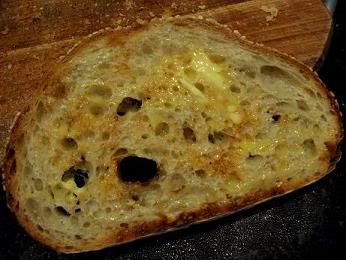
We know that toasting a slice of dry bread temporarily gelatinizes the starch and makes the crumb crunchy and edible. But try toasting a moist bread, Wow! The soft crispiness you get from Chia sourdough is amazing.
It has been a gloomy old day, drizzling and overcast. It's been like that for the last few days. Nothing to look out of the window for, but something warm in my kitchen:
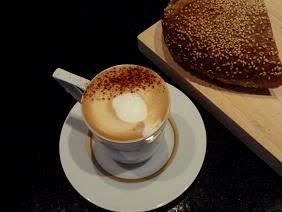

Shiao-Ping

Feinbrot - 37% bread flour, 35% whole wheat, 28% rye
Feinbrot crumb




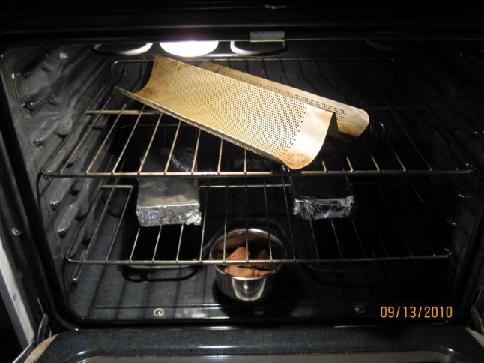


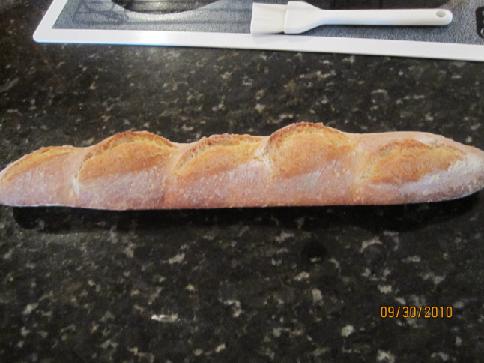

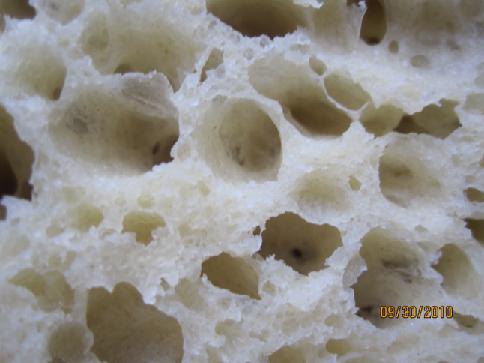
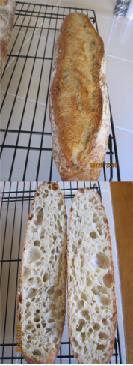


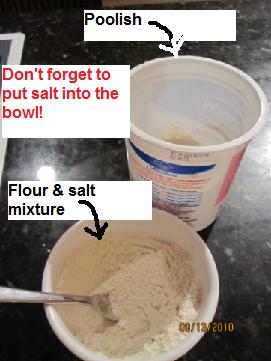
 Take the dough out of the FP
Take the dough out of the FP


 and turn the dough angle 90 degree, and repeat and repeat.... (around 1-2 minutes) You will feel the dough has gluten development. Don't do too much! * I think that you can stroke it too.
and turn the dough angle 90 degree, and repeat and repeat.... (around 1-2 minutes) You will feel the dough has gluten development. Don't do too much! * I think that you can stroke it too.

 Pull the both sides from the center very gently.
Pull the both sides from the center very gently. Using a dough cutter, lift the edge on your side( bottom) and...
Using a dough cutter, lift the edge on your side( bottom) and... bring it to the center.
bring it to the center. Next, Lift the edge on your over side ( top)
Next, Lift the edge on your over side ( top) bringing it to your side ( bottom ) and pinch very lightly
bringing it to your side ( bottom ) and pinch very lightly take the seam line onto the center..
take the seam line onto the center.. Take the dough on your over side (top) toward the dough on your side ( bottom) and pinch very well.
Take the dough on your over side (top) toward the dough on your side ( bottom) and pinch very well. Roll the dough using a dough cutter.
Roll the dough using a dough cutter. Place the dough onto a parchment paper.
Place the dough onto a parchment paper.
 Prepare Flour, Greased razor with shortening, Spray water bottle, and the ziplock is shortening inside( I was squeezing into the cuts after scoring to have ears and glooms. )
Prepare Flour, Greased razor with shortening, Spray water bottle, and the ziplock is shortening inside( I was squeezing into the cuts after scoring to have ears and glooms. )

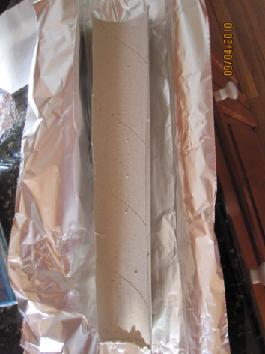

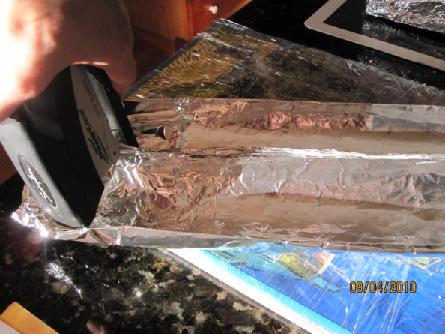
 You can slide it into the oven!!
You can slide it into the oven!! !! The side which you slide it in must be really smooth and flat like this picture.!!
!! The side which you slide it in must be really smooth and flat like this picture.!!
 I made a lot of holes for the dough to breath when you place the dough onto the canvas or cloth.
I made a lot of holes for the dough to breath when you place the dough onto the canvas or cloth.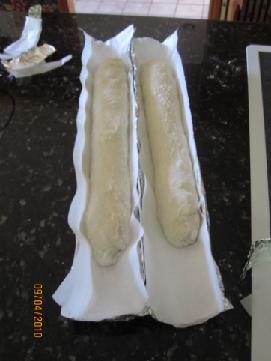 .
. 

 When you use a cloth for such high hydration dough, I suggest you to have some nice supports for the dough like these pictures above)
When you use a cloth for such high hydration dough, I suggest you to have some nice supports for the dough like these pictures above) Result : 0.4% yeast ( Poolish 1/8tsp, final dough 1/8tsp)
Result : 0.4% yeast ( Poolish 1/8tsp, final dough 1/8tsp) Result 0.8% yeast ( poolish 1/4tsp, final dough 1/4tsp )
Result 0.8% yeast ( poolish 1/4tsp, final dough 1/4tsp )











